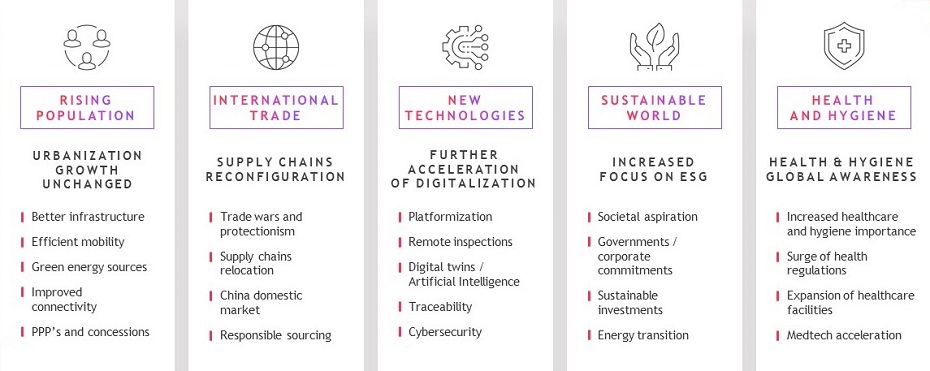2025 strategic direction: taking the group’s value creation to the next level
With its 2025 Strategy, Bureau Veritas continues its value creating journey ensuring both short- and long-term growth, by capturing the maximum value from existing businesses as well as in businesses adjacent to our core activity and by leading sustainability in the TIC sector. We will build upon the strengths of Bureau Veritas, of which our ability to be extremely reactive and our efficient execution will constitute the corner stones of our success in the years to come.
Powerful megatrends supporting the development of the tic sector
In order to accelerate its transformation and growth, Bureau Veritas will capitalize on underlying market trends that are picking up speed around the world, starting with those that will have the greatest impacts on the TIC Industry, and particularly on BV’s business portfolio.
Greater resiliency today and more business tomorrow
Value drivers: the backbone of the strategy
Bureau Veritas is capitalizing on the successful delivery of the previous strategic plan and relies upon the key fundamentals of the TIC market, which offer solid growth prospects. This roadmap is based upon 3 Value Drivers:
- Scale: Bureau Veritas aims to capture the maximum value of its existing assets, capabilities, and geographies by accelerating the standardization and replication of its existing service offer. The transformation journey will continue towards an even more market-oriented organization, capitalizing on significant investments made during the last 6 years, both internally and externally. This will boost organic growth;
- Expand: Bureau Veritas will focus notably on sustainability and the energy transition, both of which represent exciting opportunities for growth. The Group will take full advantage of cross-cutting growth opportunities that will arise alongside macro-economic and societal shifts (5G, new mobility, etc.). This will be achieved through increased penetration of rising and high-value markets, and by capturing both organic and external growth opportunities;
- Lead: Bureau Veritas will invest in businesses that have the potential to become part of the TIC core business in the future. The Group will fully take advantage of technological shifts to be well-positioned on key trending topics such as connectivity, traceability, and cybersecurity. Like Expand, Lead involves both organic and external growth.
Enablers: the key levers to execute bv strategy
The execution of Bureau Veritas’ 2025 Strategy is supported by 3 Enablers:
- People and Culture: Bureau Veritas’ success, its ability to serve its clients and differentiate itself, its capability to innovate and grow sustainably are highly dependent on its human capital. How the Group attracts the best talents, how it retains its experts, how it develops its next generations and how, ultimately, it builds its culture across the organization are critical to the 2025 Strategic Direction;
- Organization and Governance: For 200 years Bureau Veritas has been helping its clients to improve their practices related to health, safety, quality, social and environmental protection. The Group has to be exemplary. This is Bureau Veritas’ conviction and commitment, for its clients, for its shareholders, for society and for itself. 2025 objective is leading the TIC industry in ESG (Environmental, Social and Governance criteria);
- Innovation and Digital: Innovation and digital are key enablers to accelerate BV 2025 Strategic Direction execution, to anticipate its clients’ needs, to help them ensure more efficiency regarding their assets, systems and products, and to accompany them in their own digital transformation.
Overarching themes: fueling business opportunities
Bureau Veritas has consolidated all strategic priorities along 5 overarching themes. All these areas of investment were built upon BV’s capabilities and longtime expertise, and are fully aligned to the megatrends:
- Asset Lifecycle solutions, boosting management activities throughout the lifecycle of an asset;
- Sustainability Assurance, giving credibility to our clients’ sustainability strategies;
- Energy Transition Conformity Assessment, accompanying our clients in their energy transition strategies;
- Technology and Online Retail, helping our clients in their conformance, performance, or security requirements;
- Cybersecurity Compliance, which will be a relevant part of our portfolio in the future.
2025 financial ambitions and assumptions
As part of its strategy, the Group set a new mid-term financial ambition:
| 2025 ambition | |
|---|---|
| GROWTH | Resilient enhanced organic growth: mid-single-digit |
| MARGIN | No compromise on margin: above 16%1 |
| CASH | Strong Cash Conversion2: superior to 90% |
The use of Free Cash Flow generated from our operations will be balanced between Capital Expenditure (Capex), Mergers & Acquisitions (M&A) and shareholder returns (Dividend):
| 2025 ASSUMPTIONS | |
|---|---|
| CAPEX | Between 2.5% to 3.0% of Group revenue |
| M&A | Disciplined and selective bolt-on M&A strategy |
| DIVIDEND | Pay-out of around 50% of Adjusted Net Profit |
2025 sustainability ambitions
Beyond Financial performance, Bureau Veritas remains committed to its extra-financial performance.
The Group presented its strategy for social and environmental responsibility up to 2025. This strategy, aligned with the United Nations' Sustainable Development Goals (UN SDGs), aims at “Shaping a Better World”. It is built upon three strategic axes: “Shaping a better workplace”, “Shaping a better environment” and “Shaping better business practices”; and three sustainability pillars: “Social & Human capital”, “Natural capital” and “Governance”.
Bureau Veritas will track and report annually its CSR performance through 18 selected key performance indicators. In addition, the Group is committed to the achievement of five key performance indicators through 2025.
| United nations' sdgs | 2025 target | |
|---|---|---|
| SOCIAL & HUMAN CAPITAL | ||
| Total Accident Rate (TAR)3 | #3 | 0.26 |
| Proportion of women in leadership positions4 | #5 | 35% |
| Number of training hours per employee (per year) | #8 | 35.0 |
| NATURAL CAPITAL | ||
| CO2 emissions per employee (tons per year)5 | #13 | 2.00 |
| GOVERNANCE | ||
| Proportion of employees trained to the Code of Ethics | #16 | 99% |
1 Adjusted operating margin at constant exchange rate.
2 Net cash generated from operating activities before corporate tax/Adjusted Operating Profit, on average over the period.
3 TAR: Total Accident Rate (number of accidents with and without lost time x 200,000/number of hours worked).
4 Proportion of women from the Executive Committee to Band II (internal grade corresponding to a management or executive management position) in the Group (number of women on a full-time equivalent basis in a leadership position/total number of full-time equivalents in leadership positions).
5 Greenhouse gas emissions from offices and laboratories, tons of CO2 equivalent per employee and per year for Scopes 1, 2 and 3 (emissions related to business travel).



